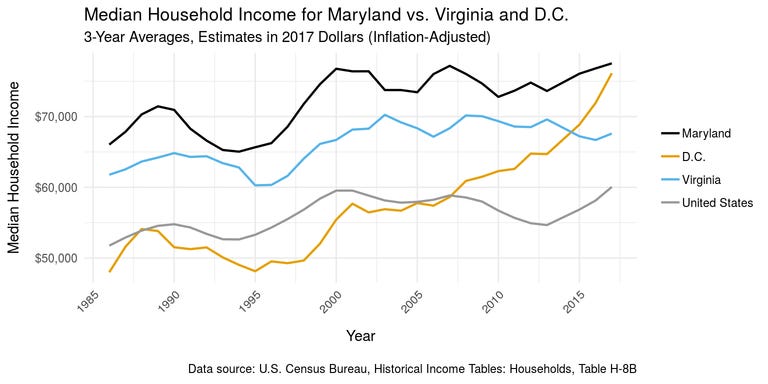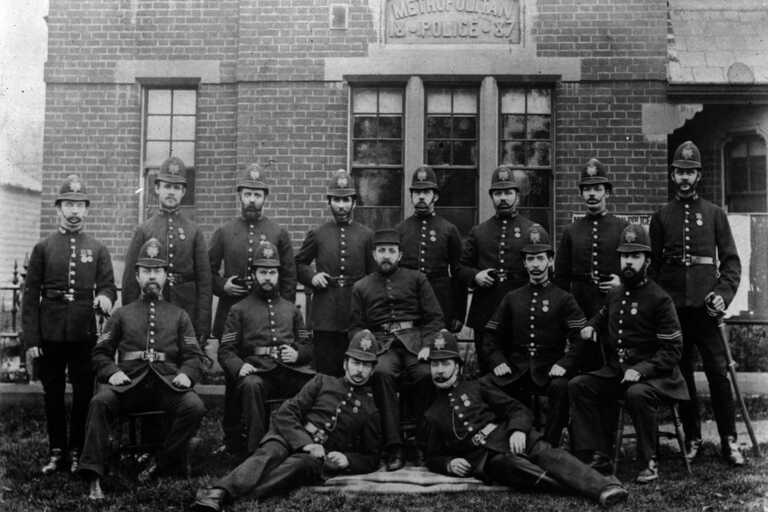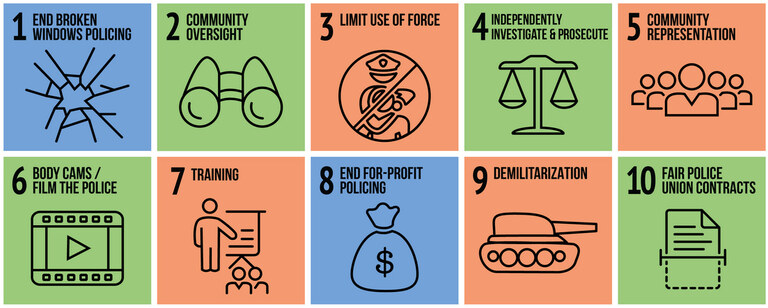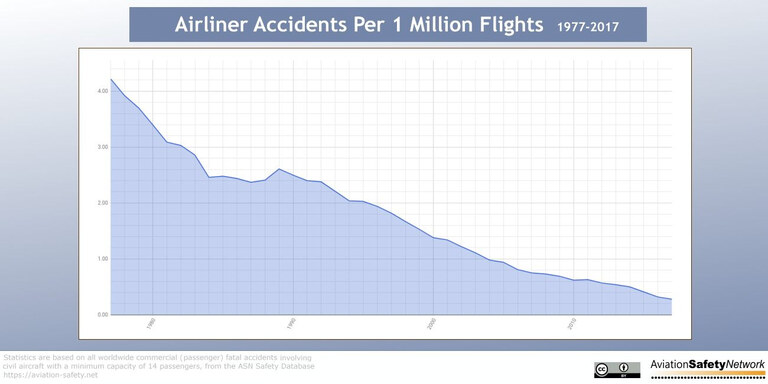UPDATE 2024/01/04: This post originally appeared on my Civility and Truth Substack newsletter. I’ve moved it to my main site in an effort to collect all of my writing in one place.
“What do you think we need to do to elevate Maryland?” That’s the last question that co-hosts Candace Dodson Reed and Tom Coale typically ask their guests on the Elevate Maryland podcast. I’m not important enough to be invited on the show, but I can tell you what my answer would be: To “elevate” Maryland will require “elevating” Baltimore, because Baltimore’s success (or failure) will ultimately drive Maryland’s success (or failure).
A few days ago I had to go into Washington, DC, for business. As I drove in through northeast DC, I was struck by the newly-constructed and under-construction apartment buildings, the new stores along H Street (including a Whole Foods Market), and the new streetcar line that begins at Union Station and runs through this section of the city.
These are the physical manifestations of a meteoric rise in DC’s economic fortunes, as shown in the above graph that I created for an earlier post. In less than 25 years DC has gone from having median household income well below the national median to having close to (and in the latest statistics, exceeding) the median household income of Maryland, itself the state with the highest median household income.
DC’s good fortune has in turn maintained and lifted the economic fortunes of the various jurisdictions of northern Virginia, with Loudoun County pulling away from Howard County in terms of median household income, Stafford County advancing into a tie with Howard County, and Fairfax County continuing to outpace Montgomery County. (See another earlier post for details.)
The difference between Washington, DC, and Baltimore is that DC, like New York City or Los Angeles, is an “indispensable city.” As the center of national political power it will continue to attract attention, migration, and (as a consequence) investment from the rest of the country. Baltimore, like Philadelphia or Pittsburgh (to give but two nearby examples), is in no way indispensable. It is a regional center whose economic and other status ultimately depends only on the region that it serves. Put bluntly, if Maryland doesn’t care about Baltimore then no one else will either.
I’d add that Howard County isn’t an “indispensable county.” If Baltimore declines in its fortunes and that decline drags down its suburbs economically and otherwise, there’s always Loudoun County for people and/or companies to move to, or Fairfax, or Stafford, or Prince William, or any number of places far enough away so that Baltimore is just a place you might occasionally hear about on the evening news.
If elevating Maryland requires elevating Baltimore, then the question becomes “What do you think we need to do to elevate Baltimore?” I make no claim to being an expert, but I’ll go back to my earlier argument that the primary focus should be on reducing crime and improving policing. To repeat what I wrote previously:
Reducing crime is fundamental because ensuring the security of its citizens is the first and foremost task of any government. Improving policing is fundamental because we expect our governments to go about the task of ensuring citizens’ security in a way that embodies the ideals of a liberal democracy, as opposed to resembling the practices of a police state, an occupation force, or a paramilitary group.
No one should have to live in an environment marked by constant criminal violence. In addition to its effects on individuals, it has a corrosive affect on the neighborhoods and cities in which it occurs. Efforts to build communities and promote their economic development cannot be expected to succeed in the absence of adequate security for their inhabitants.
Let’s go back to my earlier comparison between Baltimore and Washington, DC. Young people and people who’ve recently moved here may not realize it, but there was a time when DC was seen as a city overwhelmed by violent crime. As shown in the graph above, in the early 1990s DC had a murder rate about twice that of Baltimore and well over ten times that of the nation as a whole.
Since then the DC murder rate has dropped to a level comparable to that of New York, a city heralded for its reductions in crime, while Baltimore’s murder rate has (in years not shown in the graph above) grown to a level higher than that in the early 1990s. (According to FBI statistics, in 2018 Baltimore had 309 murders in a population of 605,436, for a murder rate of just over 51 per 100,000 people.)
The murder rate is often seen as a reliable marker of the amount of crime in a city, murder being the crime that is least likely to go unreported. By this measure Baltimore is seen as a lawless city, almost (but not quite) as lawless as DC was during its worst days.
To rephrase the “elevate” question once again, “What do you think we need to do to reduce crime in Baltimore?” As I wrote above, I’m not an expert in this area, so I don’t have any detailed recommendations. I think it’s fairly clear what won’t work though, namely trying to wage a literal “war on crime.”
I’d rather look to principles of policing that are almost two hundred years old, laid down when the first professional police force in England, the Metropolitan Police of London, was established under the supervision of Conservative Home Secretary Robert Peel. (More recently “Peel’s principles” were popularized by William Bratton, former police chief of New York and Los Angeles. Bratton also for a time served as a consultant to the Baltimore police force, but I don’t know what influence he had, if any.)
The very first principle is that the goal of a police force is “to prevent crime and disorder, as an alternative to their repression by military force and severity of legal punishment [emphasis added].” In other words, there’s no “war” called for here.
The very next principle is that the police should “recognise always that the power of the police to fulfil their functions and duties is dependent on public approval of their existence, actions and behaviour, and on their ability to secure and maintain public respect.” That gets into the topic of this section, and a focus of my earlier post:
How can police forces (and, by extension, those who oversee them), reduce the frequency with which police officer kill unarmed members of the general public, especially unarmed African Americans, and especially unarmed African American men? Just as the murder rate is a key indicator for the crime rate in general, the frequency of such killings serves as a indicator of general levels of police violence, brutality, and corruption.
Why is this reducing the number of people killed by police important? There are some people who point out that the chances of an unarmed African American man being killed by police are extremely low, and far less than being murdered by someone else. Based on my analysis, this claim is correct. But in my opinion that’s ultimately beside the point. The chances of an American being killed by radical Islamic terrorists are also extremely low (lower, in fact), yet since 9/11 the US has spent billions if not trillions of dollars in an effort to combat this threat.
The fact is that even a relatively low rate of police killing unarmed African Americans results in an almost weekly stream of such stories, and that in turn drives their perception of police and their willingness to cooperate in the attempts by police to reduce crime. To quote James Smith, the neighbor of Atatiana Jefferson whose concern for her safety resulted in a police officer shooting her in her home: “They tell you if you see something, say something . . . but if it causes someone to lose their life, it makes you not want to do that.”
Or as the third principle of policing puts it, the police should “recognise always that to secure and maintain the respect and approval of the public means also the securing of the willing co-operation of the public in the task of securing observance of laws.” The number of police officers is very small in comparison to the population at large. If the people affected by crime fear cooperating with police then “securing observance of laws” becomes a difficult if not impossible task.
So now we come to the next question, “What do you think we need to do to reduce killings of unarmed people, especially African American people, by police?” Again, being no expert I will defer to others to make their case. One of the more interesting ones I found was in a Twitter thread by Samuel Sinyangwe, one of the Black Lives Matter activists who founded Campaign Zero. Both the goal and the approach of Campaign Zero are summarized on their website: “We can live in a world where the police don’t kill people by limiting police interventions, improving community interactions, and ensuring accountability [emphasis in the original].”
What I found interesting about Sinyangwe’s thread is that he is apparently willing to go where research leads him, including against some common notions about what will work. For example, although “body cams” are number 6 on the list of items highlighted on the Campaign Zero website (see the above graphic), Sinyangwe begins his thread by claiming that “the most discussed ‘solutions’ to police violence have no evidence of effectiveness. For example, Body cams don’t reduce police violence.”
This makes sense to me. For one thing, police can always turn them off. For another, many if not most situations in which police use deadly force are going to be difficult to judge in an unambiguous manner, and even after watching body cam videos prosecutors, judges, juries, and the general public alike are likely to give police the benefit of the doubt even in situations when they arguably do not deserve it.
Sinyangwe continues to debunk by-now-conventional wisdom in his second point: “There is no evidence that better police training programs or ‘implicit bias’ training changes police behavior.” Note that this contradicts item 7 on the nominal Campaign Zero list. In particular, the claimed ineffectiveness of implicit bias training, and by extension the claimed ineffectiveness of the “implicit association test” or IAT popular among employers and in other contexts, echoes a point I’ve seen made by others in a more general context: what really matters is not what people think and believe, it’s what the incentives are that drive their behavior.
Or to put it another way, if one takes the concept of “structural racism” seriously, then the emphasis should be on the “structural” rather than the “racism,” at least in the sense of racist attitudes that might be held by individual people, or in this case by individual police officers. We need to look at the broader set of conditions under which police operate, and change those conditions in a way that will promote changes in behavior.
The name “Campaign Zero” implies that the goal is to totally eliminate police killings of unarmed people. It’s certainly a laudable goal. Is it a realistic one? Or should we simply accept the current rate of killings as an inevitable accompaniment to police doing their job?
Rather than look to the policing situation in other countries, I thought it would be interesting to compare this to another challenge, namely reducing as much as possible commercial airplane crashes and the attendant loss of life. At one time flying commercial airlines was relatively dangerous—likely not as dangerous as driving a car (I haven’t looked up the statistics on this), but certainly air crashes were relatively frequently in the news.
However, as can be seen in the graph above from the Aviation Safety Network, the last forty years have seen a dramatic reduction in the rate of airline crashes, by about an order of magnitude. (The graph expresses this in terms of accidents per million flights. Since airplane crashes tend to happen on takeoff or landing, with accidents during the rest of the flight very uncommon, this is probably a better indicator than crashes per passenger-miles.)
This improvement was the result of a concerted and continuing focus on determining why air crashes occurred and then seeking to eliminate as much as possible the underlying root causes, whatever they might be. The campaign was carried out under the auspices of government agencies (including FAA, NASA, and the NTSB) with the cooperation of airlines, airplane manufacturers, and pilots and the pilots’ union.
We can imagine a similar officially-sponsored and supported campaign focused on driving to zero the number of police killings. However the two situations are different in the ways incentives are aligned (or not aligned, as the case may be).
For example, air crashes typically result in the deaths of both pilots and passengers, so pilots have just as much incentive to avoid crashes as passengers. However in police killings there is a conflict between officers’ desires to protect themselves from harm and the interests of those whom they encounter in preserving their own lives. Incenting officers to be less ready to resort to deadly force will be easier if other measures are seen to make policing less risky.
Airline pilots and police officers are also both unionized, and like other unions pilot and police unions are incented to put the private interests of their own members before the interests of others, including the general public. In the case of airline crashes the pilots’ union was and is concerned that pilots not be unfairly blamed for crashes in which pilot error, even if present, was but one factor among many in causing a crash. Similarly, police unions may be more or less resistant to measures to reduce police killings depending on the extent to which those measure focus on the immediate behavior of officers as opposed to larger organizational issues.
Finally, and perhaps most important, social, economic, and political elites had a major interest in improving air safety, since especially prior to cheap airfares they were much more likely to travel by air than typical people. However, from the perspectives of elites the killing by police of unarmed people is a problem that happens to someone else, and rarely if ever to them, and thus they have no direct interest in addressing it. Crime levels in general can affect them, but again they have ways of removing themselves from the problem, ways that are not available to ordinary people. Even political elites may not have a direct interest in solving the issue, if their electoral success doesn’t depend on addressing it.
So, to recap: I think the fate of Maryland is tied to the fate of Baltimore, the fate of Baltimore is tied to the success (or lack thereof) in reducing crime to levels comparable to those of cities like DC and New York, reducing crime in Baltimore will depend on policing that promotes cooperation in that portion of the public that has the most interactions with police, and that in turn requires addressing the problem of police killings and police violence in general.
While activists can promote new visions of how policing can be improved, as the Campaign Zero activists have done, in the end only elites, and in particular political elites—including those who populate the guest lists for the Elevate Maryland podcasts—are in a position to do what needs to be done to create an effective and responsible police force in Baltimore. Time will tell whether they are up to the task.




